The recent high-profile pancreatic cancer cases of actor Patrick Swayze and Apple CEO Steve Jobs have called attention to the more than 37,000 Americans who are diagnosed with the disease each year, according to the National Cancer Institute. Although more than 95 percent of pancreatic cancer patients will die within five years of receiving a diagnosis, only 7 percent of patients are diagnosed in the early stages of the disease, when it is most treatable.
Spectroscopic methods that could detect pancreatic and other types of cancer earlier are being developed by professor Vadim Backman and his students at Northwestern University in Evanston, Ill., a suburb of Chicago. The researchers have been collaborating with gastroenterologists Randall Brand and Hemant Roy of NorthShore University HealthSystem (formerly Evanston Northwestern Healthcare).
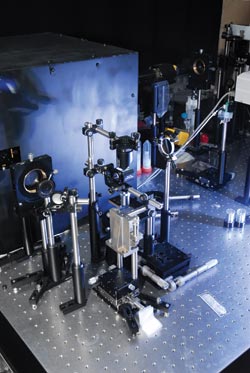
The researchers have been developing their light-scattering spectroscopy technique in the lab using the equipment shown here. Courtesy of Northwestern University and NorthShore University HealthSystem.
As detailed in Disease Markers in 2008 (Vol. 25, No. 6), the gastroenterologists used an endoscope to remove tissue from the duodenum, a part of the small intestine near the pancreas. They chose the duodenum because it is hardier than the pancreas, which can become dangerously inflamed if disturbed, and it is easier to reach via endoscope. Tissue changes that are indicative of pancreatic cancer often occur in the duodenum.
Clinically relevant
The researchers in the Backman lab analyzed duodenum tissue from 203 patients using a light-scattering technique that they developed in the lab. “We are excited by this technique because it enables sensing subtle changes in tissue that otherwise are undetectable with conventional microscopic examination,” Backman said.
The spectroscopic technique involves shining polarized white lamp light on the tissue and recording with a spectrograph the properties of the light scattered by the tissue. The spectrograph enables angular, azimuthal, spectral and polarization measurements. These four measurements can be plotted as colorful four-dimensional graphs. These graphs uniquely identify cancerous tissue analogous to the way that fingerprints uniquely identify people.
This technique works because of the unique structure of precancerous, cancerous and normal tissue. The way that cancerous or precancerous tissue scatters light is different from the way that normal tissue scatters light.
The technique detected precancerous tissue with 95 percent sensitivity and 71 percent specificity. In other words, 5 percent of patients had false negatives and 29 percent had false positives after testing. These results confirmed an earlier study of 51 patients, published in the Aug. 1, 2007, issue of Clinical Cancer Research.
The larger sample size allowed the researchers to calculate a statistic called the “area under the receiver operator characteristic,” or AUROC. Clinically relevant tests typically have an AUROC greater than 70 percent, and Backman’s test had an accuracy of 85 percent.
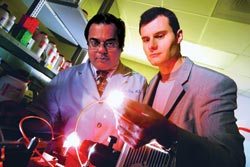
Hemant Roy (left) and Vadim Backman show off a portable version of their spectroscopy tool that could help detect colon and pancreatic cancer earlier. Courtesy of Northwestern University and NorthShore University HealthSystem.
In the past, the Backman group, Roy and Brand had used a portable version of the spectrometer to look for colon cancer without performing a full colonoscopy. In fact, they were able to get results by scanning merely the lower few centimeters of the colon. “In the fictional world of Star Trek, a doctor is able to make a diagnosis without ever interrogating an organ,” Backman said. “Biophotonics shows that this approach may be closer to reality than one might expect.”
An article published in the Feb. 15, 2009, issue of Optics Letters describes a related pilot study in which the researchers used partial-wave spectroscopy. In contrast to their other method, which enables examination of the microarchitecture of tissue, partial-wave spectroscopy is done under a microscope and shows nanoarchitectural changes within individual cells, according to Backman and Yang Liu, who was Backman’s postdoc and now is an assistant professor at the University of Pittsburgh.
The researchers used partial-wave spectroscopy to examine pancreatic cells from nine patients with pancreatic cancer and seven without the disease. Partial-wave spectroscopy quantifies the refractive index of the scattered light as it exits the cells. The researchers correctly identified all of the cells as either cancerous or healthy and even found cancer cells missed by pathologists.
Related studies
At the University of Connecticut Health Center in Farmington, assistant professor Paul Campagnola and his colleagues have been developing second-harmonic-generation microscopy for detecting various diseases, including cancer. With gynecologist Molly Brewer at the health center, they performed second-harmonic-generation microscopy on ovarian tissue.
Second-harmonic-generation imaging revealed fibers of collagen, the most common protein in connective tissue. The arrangement of the fibers differed noticeably among normal, high-risk and malignant tissue. Therefore, the researchers were able to use second-harmonic-generation imaging to distinguish among these types of tissue.
Campagnola spoke about this study in January at Photonics West. He said that he expects to submit very soon a full report for publication in Cancer Research.

The researchers used an endoscope to remove tissue from the duodenum, which is next to the pancreas, and then used their spectroscopy technique to determine whether the patient had pancreatic cancer.
The researchers hope that this technique will become a noninvasive “optical biopsy” tool, replacing the traditional invasive biopsy. Campagnola told BioPhotonics that he envisions that second-harmonic generation will be incorporated in an endoscope someday so that gynecologists can use it to identify ovarian and related female reproductive cancers. Campagnola plans to investigate second-harmonic generation of breast cancer next.
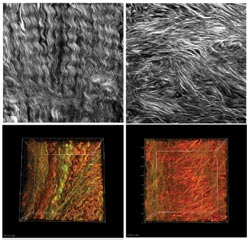
The images on the left show normal ovarian tissue and on the right show cancerous ovarian tissue. On top are two-dimensional black-and-white second-harmonic-generation images, and on the bottom are colorized 3-D renderings of the top images. Courtesy of P. Campagnola.
To do second-harmonic-generation imaging, the researchers used a Ti:sapphire femtosecond laser, a microscope, photomultiplier tubes and ImageJ software.
Laser operation
Femtosecond lasers – lasers with pulses as fast as 10−15 seconds – could enable surgeons to remove tumors more safely. Although they have been used in lasik surgery for a long time, the systems are big and bulky.
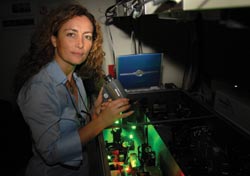
Adela Ben-Yakar stands next to her femtosecond laser. In her most recent endeavor, she has developed part of a compact femtosecond laser system that fries cancer cells. Photo by Erin McCarley.
Adela Ben-Yakar and her students at the University of Texas at Austin have designed a femtosecond laser probe, a step toward a system that is significantly smaller. According to Ben-Yakar, femto second lasers are safer than other lasers because they generate less heat.
Ben-Yakar collaborated with Olav Solgaard of Stanford University to design a miniaturized scanning mirror that would become a key part of the laser probe. Ben-Yakar and grad student Chris Hoy designed a new fiber optic cable that can withstand the intense light pulses from the femtosecond laser. The fiber is currently 15 mm in diameter. Within a few years, the Ben-Yakar lab expects to make 5-mm fibers that will fit into the endoscopes used today for laparoscopic surgery.
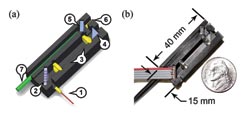
The probe developed by Ben-Yakar and grad student Chris Hoy is about the size of a nickel. The parts of the fiber are (1) an air-core photonic crystal fiber and collimating GRIN lens (2) a two-axis MEMS scanner, (3) miniature aspheric relay lenses, (4) mirror, (5) dichroic mirror, (6) a 0.46-NA GRIN objective lens, and (7) 2-mm-core plastic optical fiber. Reprinted with permission of Optics Letters.
The probe consists of an air-core photonic crystal fiber, a two-axis microelectromechanical systems (MEMS) mirror, a miniature relay lens system and a gradient index (GRIN) objective lens. It is smaller than a 9-V battery and, not only can it destroy cancer cells with high-energy femtosecond pulses, but it also can enable two-photon imaging with low-energy pulses. The researchers used it with a Mai Tai laser.
To demonstrate what the laser system can do, they arranged breast cancer cells on a three-dimensional collagen scaffold to mimic breast tissue. They found that they can deliver pulses 250-µm deep inside tissue. “You can remove a cell with high precision in 3-D without damaging the cells above and below it,” Ben Yakar said, “and you can see, with the same precision, what you are doing to guide your microsurgery.” This study was published in the June 23, 2008, issue of Optics Express. In the past, the Ben-Yakar lab has done neural regeneration studies with the laser.